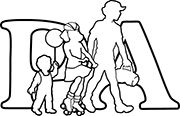Asthma is a very common condition affecting people of all ages and approximately 10% of the population. Asthma is a chronic inflammation of the airways of the lung. The triggers for asthma vary from person to person and can include allergies like pollen or dust, respiratory infections like cold viruses, influenza or pneumonia, exercise, irritants like tobacco smoke or air pollution, and weather changes such as cold temperatures.
These triggers affect the airways by causing inflammation and mucus production. These processes narrow and plug the airways making it difficult to breathe. Common symptoms include cough (especially at night), wheezing, chest tightness, and shortness of breath or labored breathing. Wheezing is a high-pitched, whistling noise that by definition occurs when air is breathed out of the lungs through narrowed airways. It may not be apparent that a patient is wheezing, even during a severe, life-threatening attack. Fortunately, most patients have only mild symptoms, and can treat their asthma symptoms with special medications to prevent any complications.
Treating asthma patients requires an individualized approach – no two patients are alike. Factors to consider are the types of triggers, the severity of the disease, the age of the patient, preferred routes of administering the medications (by mouth or inhaled), and medication side effects, to name a few. In general, there are two types of treatment: as-needed, rescue medicines and daily, controller medicines. Also note that many asthma medications come as inhalers, medicines that are sprayed into the mouth and breathed into the lungs. Not all inhaled medicines are the same and great care should be taken to learn about the different kinds and their different uses.
As the name implies, rescue medicines are used as-needed in emergency situations when a patient’s asthma flares up or worsens, which is usually characterized by wheezing, chest tightness or labored breathing. The most commonly used rescue medicine is albuterol (common brand names are ProAir or Ventolin). All asthmatics should have access to albuterol at all times in case of an asthma attack. Though usually well tolerated, albuterol does have side effects that can include increased heart rate and jitteriness. Except in exercise-induced asthma, albuterol should never be used as a controller medicine. If a patient needs albuterol more that 2 times per week that patient should consult with his/her physician to discuss using an alternative medicine for daily control.
In contrast to rescue medicines, controller medicines are used daily to prevent asthma attacks. In other words, you take them when you are well to prevent you from getting sick. In general, controller medicines lessen the chronic inflammation in the lung’s airways thereby lessening the chances of an asthma attack. Controller medicines are used often in asthmatic patients. Once started, a controller medicine should be continued until a physician indicates it is okay to stop it. In addition, these medicines do not work as rescue medicines. Patients should not expect any immediate improvement if they take a controller medicine during an asthma attack.
One of the most common controller medicines is an inhaled steroid. Though the word steroid strikes fear in many people, these are very safe medicines with few side effects. A year’s worth of an inhaled steroid amounts to less steroid than a patient would receive in a 5 day course of oral steroids that a patient might receive for just one asthma attack. Other controller medicines are available when inhaled steroids aren’t enough to keep asthma symptoms at bay.
Determining the best treatment for any asthmatic patient begins by assessing the severity of the asthma. In addition to discussing this illness with you physician, several self assessment tools are available. For adults and parents of children 12 years and over try http://www.sleepworkplay.com/index.php. An alternative tool is available at http://www.asthmacontrol.com which includes information for younger children. Asthma action plans and additional education are available through http://www.nhlbi.nih.gov/guidelines/asthma/index.htm.
Carlos Armengol, MD, FAAP

